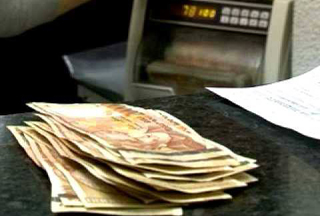
Why Armenian Dram falls

Since early December 2013 the Armenian national currency (AMD) has been weakening in the market. During the past three months AMD has been stabile falling in price.
On December 1, 2013, the exchange rate for one US dollar (USD) was AMD 403.9. On March 5 the exchange rate established by the Central Bank of Armenia was AMD 414.4, and the average price per dollar in NADAQ OEMEX exchange of Armenia was AMD 414.54. Currency exchange offices in Yerevan buy dollar at AMD 413.5-414, and sell at 418.
The official exchange rate has hit a record since the past nine months. Last time the exchange rate of dollar was more than AMD 414 was in early June 2013.
The price of Euro has skyrocketed, and now the exchange rate per Euro is AMD 570 (one year ago it was 535). There are opinions that devaluation of the national currency is not extraordinary because normally money transfers slow down in the first two months of the year.
This is true to some extent because money transfer volumes reach the highest point in December, and after holiday celebrations it slows down – almost twice in January.
During the past years this tendency existed after every holiday season. However, this year the trend of devaluation is faster than in any of the previous years.
On January 1, 2014, the official exchange rate for USD was 405.6. Now it is 414.4 – the difference is 2.17 per cent.
On January 1, 2013, the exchange rate for USD was 403.58, and on March 5 – 410.6 (the difference was 1.76%). In the same period of 2012 the national currency devaluated by 0.78%, and in the same period of 2011 – by 1.13%.
The current trends of currency fluctuation are really different as the Central Bank is more active in using tools to keep the currency exchange market stable. During the past month the Central Bank has injected approximately $60 million into the market to meet the demand for foreign currency, and during five days – the CB injected $24 million into the market. To compare, in 2013 the Central Bank sold approximately $50 million, and there was no significant transaction in through the stock exchange in the first two months of the year.
These trends show that there was huge pressure on the Armenian national currency, and if the CB did not interfere, exchange rate fluctuation would be even bigger.
The question is why AMD is falling now. Normally money transfer volumes play a role in the currency exchange rates, however now apparently it is about something more than the money transfer volume only. Even though this year during the first two months money transfer volumes into Armenia again decreased, however not more than the in the past years.
According to the CB, in January of this year the volume of money transfers through the Armenian banking system to individuals was $122.5 million, in 2012 – $95 million, in 2011 – 86.6 million, and in 2010 – 70.6 million. This year there was more money inflow compared to the previous years. This means that the fluctuation of financial inflow volumes could not have significant impact on the exchange rate.
A factor influencing the exchange rate is the negative balance of foreign trade. The trends in this year are similar to trends in the past years. In January 2014 the negative balance of foreign trade of Armenia was $197.9 million. The negative balance in January last year was almost this much too. In January 2012 the negative balance was even bigger – $202.9 million. This means that through foreign trade we have sent a lot of foreign currencies out of the country, but not more than in the previous years.
The only thing that remains to logically explain this situation is a global explanation that there is a recent trend of capital outflow from developing countries to developed ones (specifically to the US). Even though recently the Central Bank VP Nerses Yeritsyan announced that there is an inflow of capital into Armenia now, the only logical explanation for the national currency devaluation remains outflow of capital from the country.
Another factor is expectations. Due to the Russian currency weakening, people in Armenia trust the Armenian national currency less. This has not created panic yet, however, if the trend above continues, it is not excluded that in the future the Armenian Dram may skyfall.
Whether it is good or bad, it is a different question.
By Babken Tunyan























